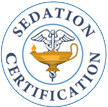
Minimal Sedation
Minimal Sedation (Anxiolysis)
A drug-induced state usually using oral medications, or the single use of a benzodiazepine, Benadryl, or narcotic not in combination with other medications, during which patients respond normally to verbal commands. Although cognitive function and coordination may be impaired, ventilatory and cardiovascular functions are unaffected.
The following signs can be used to identify minimal sedation (anxiolysis):
- Normal response to verbal stimulation
- Airway unaffected
- Spontaneous ventilation unaffected
- Cardiovascular function unaffected

Moderate Sedation
Moderate Sedation/Analgesia
Moderate sedation is a drug-induced depression of consciousness during which patients respond purposefully to verbal commands, either alone or accompanied by light tactile stimulation. No interventions are required to maintain a patent airway and spontaneous ventilation is adequate. Cardiovascular function is usually maintained.
The following signs are highlighted during this depth of anesthesia:
- Purposeful response to verbal or tactile stimulation
- No airway intervention required
- Spontaneous ventilation adequate
- Cardiovascular function usually maintained
Notes:
Reflex withdrawal from a painful stimulus is NOT considered a purposeful response.
Practitioners involved with moderate sedation must be prepared to “rescue” from deep sedation.

Deep Sedation / Analgesia
Deep Sedation/Analgesia
Deep sedation is a drug-induced depression of consciousness during which patients are not easily aroused, but respond purposefully following repeated or painful stimulation. The ability to independently maintain ventilatory function may be impaired. Patients may require assistance in maintaining a patent airway and spontaneous ventilation may be inadequate. Cardiovascular function is usually maintained.
The following signs highlight deep sedation/analgesia
- Purposeful response following repeated or painful stimulation
- Airway intervention may be required
- Spontaneous ventilation may be inadequate
- Cardiovascular function usually maintained
Conscious Sedation
is defined as any of the sedation categories listed. The term Conscious Sedation has also been called Twilight sleep, I.V. Conscious Sedation, and I.V. Sedation. It is now divided into the minimal, moderate, deep, and procedural sedation types. Anything beyond deep sedation is general anesthesia.
The purpose of Sedation Certification is to promote safe and effective sedation through education and communication to review and identify the foundation and general approaches for non-anesthesia providers to administer safe and effective moderate sedation, conscious sedation and procedural sedation in the following areas: endoscopy, emergency department, operating room, radiology, post anesthesia care unit, ophthalmology, plastic surgery, dental, surgery centers and office surgeries that offer conscious, intravenous (IV), moderate and/or procedural sedation.
This moderate Sedation Certification training course defines recommended practices for IV sedation, moderate (conscious) sedation, or procedural sedation developed for non-anesthesia registered nurses, physician assistants, physicians, dentists and podiatrists. This course addresses patient assessment, patient safety and continuum of care issues that include the ability to identify and rescue patients who may progress to an unintended deep sedation or general anesthesia. Many positions on political, legal, and ethical dilemmas concerning non-anesthesia registered nurses administering sedation are still debated and will be discussed. To learn about your State Board of Nursing’s policy on sedation, visit our convenient State Policies page that is updated quarterly. If you have any questions about your state’s policy, contact your BON.
You will learn about the nursing care of patients receiving sedation or analgesic medications while undergoing invasive diagnostic or therapeutic procedures, including medication administration, patient monitoring, discharge instructions, family and patient teaching, and patient safety concerns, which are all critical elements of nursing care for patients undergoing sedation.
This class methodically addresses the accreditation requirements set by TJC (The Joint Commission), AAAHC and NIAHO standards for sedation, and identifies critical elements of the patient’s preoperative assessment. It covers monitoring, airway, medications, IV, and how to deal with complications along with age specific considerations.

